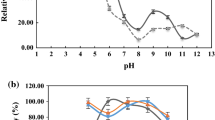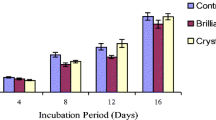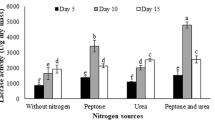Abstract
Colored wastewater from textile industries is a consequence of dye manufacturing processes. Two percent of dyes that are produced are discharged directly in aqueous effluent and more than 10% are subsequently lost during the textile coloration process. It is not surprising that these compounds have become a major environmental concern. In that context, we have evaluated the potential use of Streptomyces coelicolor laccase for decolourization of various dyes with and without a mediator. Results showed that in all cases the combination of laccase and the mediator acetosyringone was able to rapidly decolourize, to various degrees, all the dyes tested. In 10 min, decolourization was achieved at 94% for acid blue 74, 91% for direct sky blue 6b and 65% for reactive black 5. Furthermore, decolourization was achieved at 21% for reactive blue 19 and at 39% for the direct dye Congo red in 60 min. These results demonstrate the potential use of this laccase in combination with acetosyringone, a natural mediator, for dye decolourization.






Similar content being viewed by others
References
Yoshida H (1883) Chemistry of lacquer (urushi). J Chem Soc Trans 43:472–486
Alexandre G, Zhulin IB (2000) Laccases are widespread in bacteria. Trends Biotechnol 18:41–42
Claus H (2004) Laccases: structure, reactions, distribution. Micron 35:93–96
Sharma P, Goel R, Capalash N (2007) Bacterial laccases. World J Microbiol Biotechnol 23:823–832
Bertrand T, Jolivalt C, Briozzo P, Caminade E, Joly N, Madzak C, Mougin C (2002) Crystal structure of a four-copper laccase complexed with an arylamine: insights into substrate recognition and correlation with kinetics. Biochemistry 41:7325–7333
Enguita FJ, Martins LO, Henriques AO, Carrondo MA (2003) Crystal structure of a bacterial endospore coat component. A laccase with enhanced thermostability properties. J Biol Chem 278:19416–19425
Hakulinen N, Kiiskinen LL, Kruus K, Saloheimo M, Paananen A, Koivula A, Rouvinen J (2002) Crystal structure of a laccase from Melanocarpus albomyces with an intact trinuclear copper site. Nat Struct Biol 9:601–605
Piontek K, Antorini M, Choinowski T (2002) Crystal structure of a laccase from the fungus Trametes versicolor at 1.90-A resolution containing a full complement of coppers. J Biol Chem 277:37663–37669
Burton SG (2003) Laccases and phenol oxidases in organic synthesis—a review. Curr Org Chem 7:1317–1331
Kenealy WR, Jeffries TW (2003) Enzyme processes for pulp and paper: a review of recent developments. In: Goodell B, Nicholas DD, Schultz TP (eds) Wood deterioration and preservation: advances in our changing world. ACS symposium series, vol 845. American Chemical Society, Washington, pp 210–239
Mayer AM, Staples RC (2002) Laccase: new functions for an old enzyme. Phytochemistry 60:551–565
Minussi RC, Pastore GM, Duran N (2007) Laccase induction in fungi and laccase/N-OH mediator systems applied in paper mill effluent. Bioresour Technol 98:158–164
Rodriguez Couto S, Toca Herrera JL (2006) Industrial and biotechnological applications of laccases: a review. Biotechnol Adv 24:500–513
Camarero S, Ibarra D, Martinez MJ, Martinez AT (2005) Lignin-derived compounds as efficient laccase mediators for decolorization of different types of recalcitrant dyes. Appl Environ Microbiol 71:1775–1784
Moldes D, Sanroman MA (2006) Amelioration of the ability to decolorize dyes by laccase: relationship between redox mediators and laccase isoenzymes in Trametes versicolor. World J Microbiol Biotechnol 22:1197–1204
Hao OJ, Kim H, Chiang PC (1999) Decolorization of wastewater. Crit Rev Environ Sci Technol 30:449–505
Kandelbauer A, Guebitz G (2005) Bioremediation for the decolorization of textile dyes—a review. In: Environmental Chemistry, Springer, Berlin, pp 269–288
Dubé E, Shareck F, Hurtubise Y, Daneault C, Beauregard M (2008) Homologous cloning, expression and characterization of a laccase from Streptomyces coelicolor and enzymatic decolourization of an indigo dye. Appl Microbiol Biotechnol (in press)
Manu B, Chaudhari S (2002) Anaerobic decolorisation of simulated textile wastewater containing azo dyes. Bioresour Technol 82:225–231
Jahmeerbacus MI, Kistamah N, Ramgulam RB (2004) Fuzzy control of dyebath pH in exhaust dyeing. Coloration Technol 120:51–55
Hurtubise Y, Shareck F, Kluepfel D, Morosoli R (1995) A cellulase/xylanase-negative mutant of Streptomyces lividans 1326 defective in cellobiose and xylobiose uptake is mutated in a gene encoding a protein homologous to ATP-binding proteins. Mol Microbiol 17:367–377
Kieser T, Bibb MJ, Buttner MJ, Chater KF, Hopwood DA (2000) Practical Streptomyces genetics. The John Innes Foundation, Norwich
Ward AC (1992) Rapid analysis of yeast transformants using colony-PCR. BioTechniques 13:350
Kluepfel D, Vats-Mehta S, Aumont F, Shareck F, Morosoli R (1990) Purification and characterization of a new xylanase (xylanase B) produced by Streptomyces lividans 66. Biochem J 267:45–50
Childs RE, Bardsley WG (1975) The steady-state kinetics of peroxidase with 2, 2′-azino-di-(3-ethyl-benzthiazoline-6-sulphonic acid) as chromogen. Biochem J 145:93–103
Jaouani A, Guillen F, Penninckx MJ, Martinez AT, Martinez MJ (2005) Role of Pycnoporus coccineus laccase in the degradation of aromatic compounds in olive oil mill wastewater. Enzyme Microb Technol 36:478–486
Bradford MM (1976) A rapid and sensitive method for the quantitation of microgram quantities of protein utilizing the principle of protein-dye binding. Analyt Biochem 72:248–254
Claus H, Faber G, Konïg H (2002) Redox-mediated decolorization of synthetic dyes by fungal laccases. Appl Microbiol Biotechnol 59:672–678
Pearce CI, Lloyd JR, Guthrie JT (2003) The removal of colour from textile wastewater using whole bacterial cells: a review. Dyes Pigments 58:179–196
Robinson T, McMullan G, Marchant R, Nigam P (2001) Remediation of dyes in textile effluent: a critical review on current treatment technologies with a proposed alternative. Bioresour Technol 77:247–255
Machczynski MC, Vijgenboom E, Samyn B, Canters GW (2004) Characterization of SLAC: A small laccase from Streptomyces coelicolor with unprecedented activity. Protein Sci 13:2388–2397
Camarero S, Ibarra D, Martinez AT, Romero J, Gutierrez A, del Rio JC (2007) Paper pulp delignification using laccase and natural mediators. Enzyme Microb Technol 40:1264–1271
Blackburn RS (2004) Natural polysaccharides and their interactions with dye molecules: applications in effluent treatment. Environ Sci Technol 38:4905–4909
Acknowledgments
This work was supported by the Canada research chair on value-added papers from the Centre Intégré en Pâtes et Papiers (Trois-Rivières, Canada), AgroTerra Biotech (Trois-Rivières, Canada), the Institut National de la Recherche Scientifique–Institut Armand-Frappier (Laval, Canada) and the Natural Sciences and Engineering Research Council of Canada.
Author information
Authors and Affiliations
Corresponding author
Rights and permissions
About this article
Cite this article
Dubé, E., Shareck, F., Hurtubise, Y. et al. Decolourization of recalcitrant dyes with a laccase from Streptomyces coelicolor under alkaline conditions. J Ind Microbiol Biotechnol 35, 1123–1129 (2008). https://doi.org/10.1007/s10295-008-0391-0
Received:
Accepted:
Published:
Issue Date:
DOI: https://doi.org/10.1007/s10295-008-0391-0




